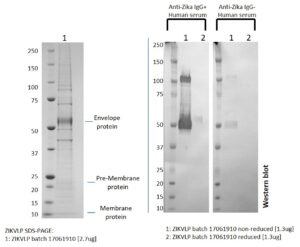
SDS-PAGE: Coomassie-stained SDS-PAGE and Western blot images of ZIKV VLPs.
Electron microscope pictures of the VLPs and associated particles.
The Native Antigen Company is part of LGC Clinical Diagnostics - Learn More
Price range: $1,425.18 through $3,003.83 excl. VAT
Recombinant Zika virus-like particles consisting of Envelope, pre-Membrane and Membrane protein produced in mammalian HEK293 human cells.

SDS-PAGE: Coomassie-stained SDS-PAGE and Western blot images of ZIKV VLPs.
Electron microscope pictures of the VLPs and associated particles.
Zika Virus VLP (Virus-Like Particle) is a unique product that has been developed in response to the need for high purity, properly assembled and glycosylated Zika virus antigens for use in the development of Zika virus diagnostics and in vaccine development and R&D (including use as an immunogen). Like its related product, Zika Virus NS1, the Zika Virus VLP is produced in human cell lines using state-of-the-art expression techniques. The Native Antigen Company Zika Virus VLP is composed of partially mature particles containing Envelope (E), pre-Membrane (prM) and Membrane (M). In contrast to our Dengue serotype 1-4 VLPs, Zika Virus VLP has been constructed purely from Zika virus sequences. Concentration and purification is then performed by a series of ultracentrifuge and chromatographical methods which result in VLPs of exceptional quality and purity.
Virus-Like Particles (VLPs) are an emerging vaccine technology. VLPs consist of protein shells comprising outer proteins specific to the virus in question. VLPs are more representative of how viral antigens are presented in vivo and while they are highly immunogenic they are non-infectious as they lack the core genetic material of the virus. Another important advantage of VLPs is that they more effectively activate key aspects of the immune response to achieve potent immune stimulation and to provide immunological memory. VLP-based vaccines have also shown to provide effective protection and are in current use for several diseases and in development for many others.
Zika virus is an emerging disease that is spread by Aedes mosquitoes. The virus was first isolated in Central Africa, and has since spread to South Asia and more recently to South America. It is a member of the flavivirus family, and is structurally closely related to viruses such as Dengue Fever Virus. Outbreaks were reported in Micronesia in 2007 and in Brazil in 2015, confirming at least 13 autochthonous infections. The Zika virus outbreak in Brazil in 2016 has gained world-wide attention, and has been linked to an increasing number of microcephaly cases. In April 2016 the Centers for Disease Control, in the USA, confirmed the link between Zika virus infection of the fetus with microcephaly.
Clinically Zika virus can cause mild fever, rash, myalgia, arthralgia and headaches, with one in four infected individuals being asymptomatic. Due to similar symptoms Zika virus infected individuals can easily be mis-diagnosed as a dengue infection and vice-versa. In addition, Zika virus has been implicated in causing microcephaly through transmission in utero. There is no vaccine or specific treatment available for Zika virus. Analysis of Zika virus sequences from infected patients have shown that the strain circulating in South America in 2015 is most closely related to the strains circulating in Asia during outbreaks in 2007 and 2013-14. The South American strain was first isolated and sequenced from a patient in Suriname, and hence is known as the Zika Suriname strain.